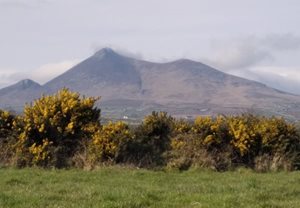I am blessed to have grown up and still live in one of the most scenic parts of Northern Ireland – the glorious Kingdom of Mourne! As I look around I am reminded daily of the wonder of God’s creation, whether it’s in the grandeur of the Mourne mountains, or in the miles of coastline where they ‘sweep down to the sea’.
But probably my favourite aspect of the Mournes are its stone walls, or ‘ditches’ as we call them locally. Not only do they look amazing, which is testament to the skill of those who built them, but on a practical level, they provide stock-proof boundaries to our fields (most of the time) and are a great source of shelter to livestock.
A memorial to hard work and ingenuity
Yet as much as I admire these great structures, I’m not sure if the men and women who built the first ditches would hold the same view. When our forefathers arrived in Mourne, they were faced with soils littered with massive granite boulders, both above and below the surface. Armed only with hammers, spades and crowbars, perhaps a horse or mule for added pulling power, countless hours were spent clearing them so the land could be farmed and families fed. But what could they do with the stones? They built the walls and on heavier soils, constructed channels that would drain the land so it could be worked.
 The Mourne stone ditches serve as a long-standing memorial to the toils of these pioneering folk, without whom farming in this area would be a real challenge today.
The Mourne stone ditches serve as a long-standing memorial to the toils of these pioneering folk, without whom farming in this area would be a real challenge today.
In the Bible, we come across several examples of stones being set up to help remind God’s people of His faithfulness. After crossing the Jordan, God ordered Joshua to take twelve men and lift stones from the riverbed, building them up on the riverbank, much like a stone ditch. This was to remind future generations, ‘“that all the peoples of the earth may know that the hand of the LORD is mighty, that you may fear the LORD your God forever”’ (Joshua 4:24).
A stone that reminds
Later, in the New Testament, God also used a stone to help remind us that His great plan of salvation had been accomplished. It was from this stone, by the entrance to an empty tomb, that His angel announced the great news, ‘“…I know that you seek Jesus who was crucified. He is not here, for He has risen…”’ (Matthew 28:5-6).
This stone reminds us today that, not only did Jesus pay the punishment for our sins through His death, but that He conquered death and is alive again. It also reminds us that as God has kept His promises to us, we can be assured that Jesus will keep His promises to us in the future. As He says in John 14:3, ‘“I will come again and will take you to myself, that where I am you may be also.”’
Even in our modern world, because of its durability stone is still the material of choice when it comes to building memorials, no matter what the weather throws at it - just like the Mourne ditches. It’s the same when we put our trust in Jesus. He promises and reassures us that no matter what life may throw at us, “I am with you always, even to the end of the age” (Matthew 28:20).
So why not build your life on Him today?
 Ronald Annett works for a local animal feed company and helps out on the family farm in the shadow of the Mourne Mountains. He is a member of Mourne Presbyterian Church in Kilkeel, County Down.
Ronald Annett works for a local animal feed company and helps out on the family farm in the shadow of the Mourne Mountains. He is a member of Mourne Presbyterian Church in Kilkeel, County Down.
His blog appeared in today’s Farming Life, a fortnightly column entitled ‘Good News for the Countryside’, where people from a farming background, or who have a heart for the countryside, offer a personal reflection on faith and rural life.
You can read Ronald’s other contributions and look at other reflections in this series of blogs here.